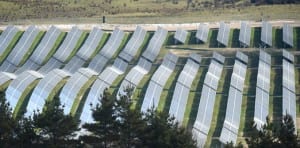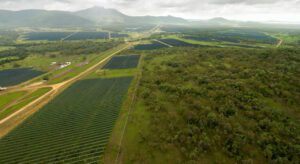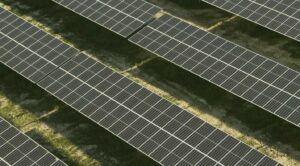It’s one of the untold stories of the large-scale solar industry in Australia. The shiny new arrays and the path that the technology shines so clearly towards a decarbonised electricity supply has created much hope, billions of dollars of investment, and thousands of jobs.
But for all of its plaudits and success, there is a dark side to the big solar sector. And it came to the fore again this week when a leading sub-contractor, R&L Solar, filed for administration.
It wasn’t the first time – R&L, which installs modules, does pilings and other mechanical services – also got caught up in the collapse of major contractor RCR Tomlinson in 2018, a crash that left unpaid bills to contractors totalling more than $120 million, according to a creditors report, and little money to settle it. Now R&L has closed its doors again, claiming it is the victim of a “fraud”, and unpaid invoices on some of the big projects it is working on.
It has been well documented that companies big and small, Australian and international, have been hit hard by write downs, delays, penalties, connection problems, constraints, construction woes, and “performance” and “technical” issues at solar projects in Australia.
Large civil contractors, like RCR Tomlinson, have collapsed under the weight of their solar problems. Others, like Biosar, a unit of Greek-based Ellaktor, have effectively quit the country. Downer, one of the biggest civil contractors in the country, dramatically declared “we’re out” and quit the solar business because of the risks. Bouygues pulled back from EPC contracting but is now cautiously re-entering the market. Others, such as Decmil, UGL, and Tempo no longer take the risk of EPC contracting and will take only specific “balance of plant” projects.
What is less known is the impact on many subcontractors, many of whom have been left out of pocket by a number of bigger contractors who have either collapsed, “phoenixed” under another name, or who have failed to pay bills because of cost over-runs. Many victims are smaller, often family-owned businesses. And at stake is the reputation of the solar industry at large.
Two companies working on that project that went into administration were identified in that article as Ozmac and Northern Territory based Rusca Bros. A spokesman for Rusca told the paper that he blamed non-payment of fees from further up the chain for the failure.

“It’s not good for the solar industry”
Another local company that requested not to be named said it, too, was still waiting for payments for work done on the Kiamal solar farm. His client went into administration and has not paid any of the local smaller sub-contractors or suppliers. And he says it is a sadly similar story across the industry.
“A lot of subbies (sub-contractors) would have lost out from that, local communities, hardware stores and shops,” he says. “It creates a negative image for a lot of these solar farms.There are heaps of local businesses that should benefit from the construction of a solar farm, but they are not. It’s not good for the solar industry.
“We’d like to get a message out. We have to innovate as an industry, together. We can’t drive down labour costs, because there is an award rate. Unless we innovate then firms won’t do much more than screwing the hell out of everybody.”
Contractors say the problem arises because some EPC contractors are coming into the industry and bidding too low on projects, and then are unable to deliver. They then select sub-contractors based only on price, potentially sacrificing quality and opening themselves up to conflict and delays, and then those subcontractors also can’t deliver, and go broke. The ultimate losers are the project owners, local communities and workers who are out of pocket.
In a letter to employees published on social media this week, before he called in Pitcher Partners as voluntary administrators, R&L Solar CEO Uwe Rosenkrantz blamed the non-payment of invoices by a number of EPC contractors, including Sterling and Wilson, which is building the 174MW Wellington solar farm, and which is now the biggest surviving EPC contractor in the country after the collapse and withdrawal of others.
(Update: Sterling and Wilson issued a statement to RenewEconomy rejecting the claim by Rosenkrantz that is was late on invoice payments and said it was seeking to work with the administrators.)
The industry view of R&L is mixed. Several developers and EPC contractors spoke highly of their work. Others suggested they were also a low bidder for contracts. Several social media posts from aggrieved employees claimed they had not been paid for weeks.
Solar is expected to lead the way, along with wind energy, battery storage, and distributed energy, to a complete transformation of Australia’s grid from one dominated by coal to one dominated by renewables. The market operator says it could reach 94 per cent renewables by 2040. It says it will be the world’s fastest energy transition. Some say it could, or should, be even quicker.
But issues have risen at too many large scale solar projects, which threatens the pace of this transition. It is difficult to judge what has happened on individual projects, but broadly it is fair to say that the blame is equally apportioned equally between the companies themselves, overburdened networks, under resourced regulators, and stiff competition, in which you could add a lack of transparency, poorly constructed regulations, lack of investment in networks, significant and abrupt rule changes, inexplicable delays, some bad mistakes and just a few cowboys.
While most solar projects have been built to good quality and high standards, and performed accordingly, too many have been affected because cheap, imported products failed – or have not been connected – when they couldn’t cope with Australian conditions, when contractors tried to cut corners but in the end can’t meet the strict standards required to gain registration or connection approval.
Liquidated damages
Often this has resulted in projects are delayed, liquidated damages are imposed, final payments are missed and the sub contractors and local community suppliers are the ones who often lose out.
Liquidated damages are a major problem. Some times they are triggered by grid problems beyond the control of either the developer or contractor. They can amount to between $50,000 to $100,000 per day, and it’s impossible to pass this on to smaller contractors. Many argue that the situation – from the problems with grid connections, and the contracting agreements, must change.
“The EPC hasn’t passed the risk … simply a small portion, and in the meantime have lost control of that section of works by sub-contracting it out. It’s bloody silly and short sighted … all in the mad rush to win projects.”
Some of these issues have been building up for a long time. Concerns were raised several years ago as contractors new to the industry flooded the market, bidding prices that raised eyebrows across the industry.
Ben Willacy, from ITK Services, says large scale solar in Australia has become a highly competitive sector with some aggressive participants looking to either grow market share or get their first foot in the door.
“I count 25 EPC contractors today (i.e. offering fully wrapped EPC services) that have either completed or are contracted to build at least one solar farm larger than 10MW DC. The full list for all sizes of solar farms comes to about 37. That’s a pretty remarkable situation for a market that had only 4 utility scale solar farms five years ago, three of which had the same EPC contractor.”
But he says five of the top 15 companies by portfolio size have now either exited or partially retreated from solar EPC services, and at least three of the others have not started a new project between them for at least two years.
Market analysts says that the problems in the industry have been two fold. On one side is the growing complexity from new connection rules, overworked and underresourced network and regulatory bodies, plus worsening grid issues, bottlenecks, and the failure of market rules and regulators to adapt.
On the other side is the lack of proper skill sets in some companies that either didn’t understand the Australian market place, or who sought to cut corners. It was an accident waiting to happen, as RenewEconomy has reported.
Even AEMO, which rarely comments on the capabilities of the sector, admitted in mid 2018 that not every new entrant was up to standard.
“We have developers who are very sophisticated. And we have developers who when asked for GPS (generator performance standard) co-ordinates (of their project), they send us a map. They don’t really know what’s going on,” CEO Audrey Zibelman said at a clean energy conference in July, 2018.
See AEMO’s Zibelman admits “hiccup” in new solar and wind connections.

Project Gretel and the first big collapse
The most spectacular failure has been RCR Tomlinson, a listed multi billion dollar construction firm which rushed into the solar industry with little prior experience and signed up contracts worth more than $1.5 billion to build 15 different solar farms.
Nearly all of these projects ran over budget or were delayed, some of them resulting in payments “liquidated damages” to the principals to make up for lost revenue, a report by the liquidators McGrath Nicol noted. Some of the project over-runs were spectacular, such as the three solar projects known collectively as “Project Gretel.”
Sub contractors and trade creditors lost out big time. Some went to the wall and had to call in their own administrators, including R&L – a company that has had positive reviews from a number of contractors that RenewEconomy has spoken to.
ITK’s Willacy says it is clear that RCR went after solar deals very aggressively, as it (quite correctly) identified the solar sector as a significant growth area that could help diversify away from the resources sector.
“As it built such a large portfolio of projects, in my view RCR effectively set the bar on pricing,” Willacy says. “The deals were struck pretty low for the time: generally between A$1 and A$1.3/watt DC. And I think what really moved the needle was that RCR appeared willing to take on all the risk, including grid connection. This is what new entrants had to compete against to win their first job.
“Clearly barriers to entry are low and complexity is low, so the number of new projects in Australia attracted a lot of competitors, but all had to bid low to get a look in. And with the connection difficulties that arose in the NEM, we know what happened next.
“The LDs (liquidated damages) that had been agreed as part of a highly competitive bidding process became enormous liabilities, particularly as much of the grid connection timing was out of the EPCs hands.
“To some extent I also believe the downward pressure on bids was a result of unrealistic expectations. PPA prices – largely untransparent – were being talked about in the A$50-60/MWh range.
“While some PPAs were struck at these levels, it was often as a way to secure finance and get a project off the ground. Equity proponents were hoping to make their return on either uncontracted portions of capacity, or a merchant tail post-PPA. But with such low PPA prices being publicised, developers and investors pressured EPC prices, which in turn likely caused EPCs to run at a very thin margin, and potentially seek some shortcuts.”
It’s difficult to put a figure on the total losses, but they are significant, for both EPC contractors and developers. The only insight come from the few companies that are listed.
Biosar is reporting losses of $178 million from Australian solar projects, John Laing has reported $120 million, RCR went down with probably more than $100 million, and the figures from other long delayed projects such as Bungala, Kiamal and Kennedy run into the tens of millions.
But some of these losses have cascaded down to the lower echelons of the market, where the impacts are felt even more keenly.
Sub-contractors say there is no doubt that new connection rules and grid bottlenecks have caused problems for EPC contractors. “That is definitely real … but the way they have been managing contracts downward are in some cases extremely ruthless. The guys below are accepting things they shouldn’t, and they are getting into trouble. It’s hard to know what the fix will be.”
Others are more damming. “The whole solar game is just a shambles,” says one. “It’s a free for all. Prices are bid low so everyone can (win contracts and) keep cash flow. They say they can build it at those prices in a third world country, but they can’t do it in Australia.”
For the issues reported by the Sunraysia Daily, RenewEconomy approached the Kiamal project owners for comment. Total Eren referred us to Biosar, which declined to comment, and the Clean Energy Finance Corp, which helped finance the project, also declined to comment about the Sunraysia daily report.
“We do not comment on individual projects, but you can you can find the publicly and official relevant data as they were announced and published on our website,” said a spokesman for Ellaktor, Biosar’s parent, by email.
Sterling and Wilson denied claims it was late for payments with R&L Solar.
Now R&L has gone down too. Others may follow, and some of the remaining players in the market suspect that they will busy for the next few years fixing up the mess created by others. For the solar industry, it’s a significant blot on the landscape, and one of the growing issues that is making investors rethink the market. It will likely mean more lengthy delays on some projects. For others, it is the loss of a dream, and their livelihood.
Related Topics








